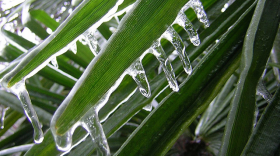BONIFAY -- After Florida’s first recorded case of a contagious disease fatal to deer, wildlife officials said Thursday other cases are likely and that it will be a “long-term marathon” to address the issue.
But it also could mean a short-term increase in hunting limits in the region of Northwest Florida where the case was found, as officials seek to quickly collect samples to determine the prevalence of chronic wasting disease.
Nearly 300 residents turned out Thursday evening to the Bonifay K-8 School in Holmes County for a presentation by the Florida Fish and Wildlife Conservation and the Florida Department of Agriculture and Consumer Services about initial steps to address the disease.
The state announced last month that a “road-killed” female white-tailed deer in Holmes County had tested positive for chronic wasting disease, which has been described as similar to mad cow disease, with deer becoming emaciated and often being found isolated and trembling. Chronic wasting disease is not known to affect people.
“Our surveillance plan is designed to detect CWD (chronic wasting disease) at the county level at a 1 percent prevalence or less, with 95 percent confidence,” Florida Fish and Wildlife Conservation Commission Veterinarian Manager Mark Cunningham said. “So, for Holmes County, the odds of us finding the one sole positive (case) is extremely unlikely. So, almost certainly there are additional positives.”
Commission Executive Director Roger Young on June 19 issued an executive order that set up a management zone covering parts of Holmes, Jackson and Washington counties. Exporting deer from the zone is prohibited.
Also, the order limits baiting or feeding deer in the zone, along with rehabilitating or releasing injured or orphaned white-tailed deer. The order doesn’t ban hunted deer being brought into the zone to be processed.
With no simple treatment or vaccine, deer farmers expressed concern Thursday that a single positive test could require the eradication of entire herds, which in some cases represent millions of dollars in investments.
State officials hope farmers and hunters in the area will help in the detection and prevention effort, which has a goal of 300 to 600 samples.
Cory Morea, the commission’s deer management program coordinator, said the goal likely will require an increase in deer harvesting in the zone.
The findings will dictate how the state approaches the disease, which in the long term could include using methods from some of the 30 other states where the disease has been detected.
“This isn't a sprint to the finish line. It's a triathlon. It's a long-term marathon,” Morea said. “Essentially, once you have it on the landscape, it's gonna be here. And we just need to do what we can to minimize the prevalence and spread.”
The Florida Department of Agriculture and Consumer Services has imposed a quarantine on captive cervid facilities — where deer are farmed — in the management zone.
While chronic wasting disease is not known to affect people, pets or other species, the federal Centers for Disease Control and Prevention recommends against eating meat from animals that test positive for the disease.
Wildlife officials are concerned that a spread of the disease could lower and destabilize deer populations, Morea said.
With Alabama and Mississippi among the states that have previously detected the disease, Florida has been monitoring the issue since 2002, testing about 17,500 hunter-killed, road-killed and sick deer. Since 2017, the state has bought equipment needed to address an outbreak.
In 2021, the state placed certain limits on importing deer carcasses into Florida. As examples, people can bring in deboned meat, finished taxidermy mounts and clean hides and antlers.
Exceptions are made for deer harvested from properties in Georgia or Alabama that are bisected by the Florida border and are under the same ownership.







